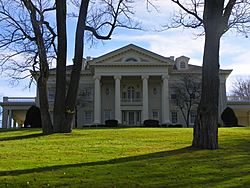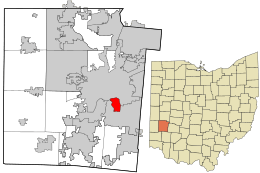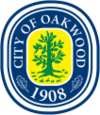Oakwood, Montgomery County, Ohio facts for kids
Quick facts for kids
Oakwood, Ohio
|
|||
|---|---|---|---|

Hawthorn Hill, home of Orville Wright
|
|||
|
|||

Location in Montgomery County and the state of Ohio.
|
|||
| Country | United States | ||
| State | Ohio | ||
| County | Montgomery | ||
| Area | |||
| • Total | 2.19 sq mi (5.68 km2) | ||
| • Land | 2.19 sq mi (5.68 km2) | ||
| • Water | 0.00 sq mi (0.00 km2) | ||
| Elevation | 981 ft (299 m) | ||
| Population
(2020)
|
|||
| • Total | 9,572 | ||
| • Density | 4,360.82/sq mi (1,684.04/km2) | ||
| Time zone | UTC−5 (Eastern (EST)) | ||
| • Summer (DST) | UTC−4 (EDT) | ||
| ZIP Codes |
45409, 45419
|
||
| Area code(s) | 937, 326 | ||
| FIPS code | 39-57764 | ||
| GNIS feature ID | 1086677 | ||
| Website | www.oakwoodohio.gov | ||
Oakwood is a city located in Montgomery County, Ohio, in the United States. In 2020, about 9,572 people lived there, according to the United States census. It's a suburb of Dayton and part of the larger Dayton area. Oakwood became an official city in 1908. John Henry Patterson, who started the National Cash Register Corporation (NCR), is often called the "Father of Oakwood" because he helped it grow.
Oakwood is completely surrounded by the cities of Dayton and Kettering. Because it's a small area, its Department of Public Safety works very efficiently. All staff members are trained as police officers, firefighters, and EMS officers. This means they can help in many different kinds of emergencies.
Contents
History of Oakwood
At the start of the 1900s, Oakwood was mostly farmland on a hill just south of Dayton. In 1913, a huge flood hit downtown Dayton. This event, known as the Great Dayton Flood, caused a lot of damage. After the flood, people started advertising Oakwood property by saying it was "275 feet higher than the intersection of Third and Main Streets." This made Oakwood seem like a safer place to live.
Because of its higher ground and closeness to Dayton, Oakwood began to grow quickly. By 1930, over 6,000 people lived there. Oakwood officially became a city in 1908. In 1932, it started using a Council/Manager form of government, which it still uses today.
One famous early resident was Orville Wright, who helped invent the airplane. His home, Hawthorn Hill, is still standing at Harman and Park Avenues. John H. Patterson, who founded the National Cash Register Company (NCR), also lived in Oakwood. The city is known for its quiet, tree-lined streets and many homes.
During World War II, a place called the Runnymede Playhouse in Oakwood was part of the Dayton Project. This project was a secret part of the Manhattan Project. Scientists there worked on making polonium, which was used in the triggers for the first atomic weapons.
Geography and Layout
Oakwood is located in the Miami Valley region of southwestern Ohio. It shares borders with Dayton to the north and east, and Kettering to the south and west. The University of Dayton campus is right next to Oakwood on its northeast side.
The United States Census Bureau states that Oakwood covers about 2.193 square miles (5.68 square kilometers) of land. There is no water area within the city limits.
The city is informally split into two parts: east and west. This division is made by State Route 48, also called Far Hills Avenue, which is the city's main road. State Route 48 runs north to south. It connects Dayton with Oakwood and other suburbs like Kettering further south. The land on the western side of the city has many hills. In contrast, most of the eastern side is flat or gently sloped.
City's Look and Feel
Oakwood has many different kinds of buildings and homes. Since the city is quite old, many houses were built before World War II. They show older designs and styles. Houses in Oakwood come in many sizes and styles. Some popular styles include Tudor, Swiss chalets, Colonial Revival, and Gothic Revival. The western part of the city has many large properties and historic homes. One example is Hawthorn Hill, which was the home of Orville Wright. These houses are often on private plots of land, surrounded by many trees.
People in Oakwood care a lot about making the city look beautiful. The community generally dislikes houses that look run-down or lawns that are not kept well. Most lawns are very neat. The city even gives out "Beautification Awards" to the most beautiful houses. This helps keep the city looking nice. Oakwood has strict zoning laws. These laws limit big changes to houses and require city approval for any new additions. For example, chain-link fences that can be seen from the street are not allowed. Also, outdoor utility units, like air conditioning units, must be hidden from street view.
The public buildings in Oakwood are also a source of pride. They are designed to match the varied traditional styles of the city's homes. Oakwood High School has a detailed outer design. The elementary schools, Edwin D. Smith Elementary School and Harman Elementary School, also have this fancy style. Smith Elementary is built in the Tudor style, like the high school. Harman Elementary is in the Colonial Revival style. The newest school building, the Julian and Marjorie Lange School, features Spanish Revival architecture. The Oakwood Board of Education is in a gray stucco mansion with a red tile roof. The Wright Memorial Library has a similar beautiful look. Even the police and fire department building looks like a French château.
Population Information
| Historical population | |||
|---|---|---|---|
| Census | Pop. | %± | |
| 1910 | 358 | — | |
| 1920 | 1,473 | 311.5% | |
| 1930 | 6,494 | 340.9% | |
| 1940 | 7,652 | 17.8% | |
| 1950 | 9,691 | 26.6% | |
| 1960 | 10,493 | 8.3% | |
| 1970 | 10,095 | −3.8% | |
| 1980 | 9,372 | −7.2% | |
| 1990 | 8,957 | −4.4% | |
| 2000 | 9,215 | 2.9% | |
| 2010 | 9,202 | −0.1% | |
| 2020 | 9,572 | 4.0% | |
| 2021 (est.) | 9,471 | 2.9% | |
| Sources: | |||
2010 Census Details
Based on the 2010 census, Oakwood had 9,202 people living there. There were 3,543 households and 2,521 families. The city had about 4,201.8 people per square mile (1,622.4 per square kilometer). There were 3,772 housing units, with an average of 1,722.4 units per square mile (665.0 per square kilometer).
Most of the people in Oakwood were White (95.3%). Other groups included African American (0.9%), Native American (0.2%), and Asian (1.4%). About 1.8% of the population was Hispanic or Latino.
Out of the 3,543 households, 41.3% had children under 18 living with them. About 58.0% were married couples. The average household had 2.58 people, and the average family had 3.15 people.
The average age in the city was 40.5 years. About 30.6% of residents were under 18. About 11.9% were 65 years or older. The population was 47.4% male and 52.6% female.
The average income for a household in Oakwood was $94,731. For a family, it was $116,719. The average income per person was $50,258. A high percentage (70.6%) of Oakwood residents had a bachelor's degree or higher.
Education System
The Lange School is where kindergarten students attend. Before 1999, kindergarten classes were held in each elementary school. Harman Elementary School and Edwin D. Smith Elementary School teach children from first through sixth grades.
Oakwood has one building that serves as both a junior high and senior high school. It provides education for all students from seventh through twelfth grades. Oakwood High School had its first graduating class in 1924. It started the tradition of a Baccalaureate ceremony at Westminster Presbyterian Church in downtown Dayton. An Oakwood student's school journey ends with the Senior Awards, Baccalaureate, and Commencement ceremonies. The high school's yearbook is called The Acorn, and its newspaper is The Dome.
Oakwood's schools strongly encourage students to go to college or other higher education. Oakwood High School is known as a national school of excellence. During the 2016–17 school year, Oakwood High School achieved the highest performance score on state tests among all high schools in Ohio. Its score was 92.0 out of 100, with no other high school in Ohio scoring above 90. Oakwood High School offers strong courses in English, math, science, and foreign languages. It also has many opportunities for students interested in performing arts. It is common for top students from Oakwood to get accepted into very selective universities and colleges. However, most graduates attend schools within 300 miles, and many stay in Ohio. Oakwood High School is consistently ranked as one of the top 10 academic schools in Ohio. It is also often listed among the top 400 in the United States.
City Infrastructure
Oakwood was historically known for hosting route 5 of Dayton's trolleybus network. This network is the second oldest of only four trolleybus systems still running in the US. The others are in San Francisco, Seattle, and Philadelphia. In 2023, the Greater Dayton Regional Transit Authority (GDRTA) decided their trolley system was outdated. They mentioned high maintenance costs and plans to invest in newer technology. The trolley lines along Far Hills Avenue, which run through Oakwood and Kettering, had not been used since 2016. This was true even though they were on major GDRTA routes serving the southern suburbs of Dayton. In 2024, GDRTA, the City of Oakwood, and the city of Kettering worked together. They planned to remove the trolley infrastructure along Far Hills Avenue by 2025.
Sister Cities
Oakwood has special connections with cities in other countries:
 Le Vésinet, France
Le Vésinet, France Outremont, Quebec, Canada
Outremont, Quebec, Canada Unterhaching, Germany (This is a friendship pact)
Unterhaching, Germany (This is a friendship pact)
See also
 In Spanish: Oakwood (condado de Montgomery, Ohio) para niños
In Spanish: Oakwood (condado de Montgomery, Ohio) para niños



